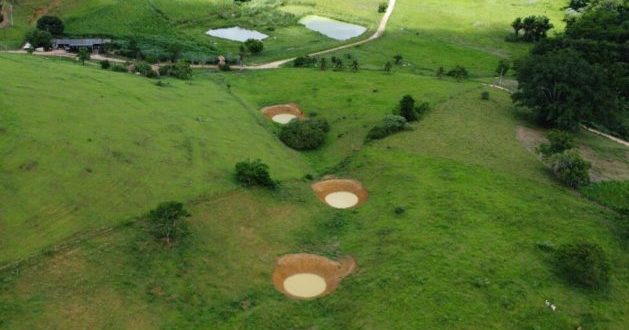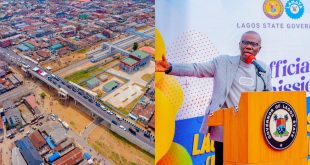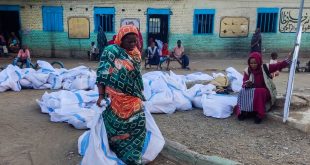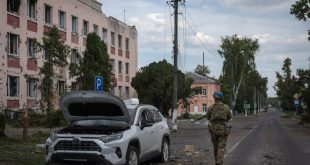
SETE LAGOAS, Brazil, Aug 18 (IPS) – Water shortage is over, springs have emerged or become perennial, small ponds with fish have formed and pastures have become greener and more permanent, all thanks to the ‘barraginhas‘, the Portuguese name given in Brazil to micro-dams that retain rainwater and infiltrate it into the soil.
This is a common claim among the many farmers who have adopted the technique developed and promoted by Luciano Cordoval, an agronomist and researcher at the Brazilian Agricultural Research Corporation (Embrapa), a public entity comprising 43 research centres throughout the country.
Cordoval has worked since 1983 at the Embrapa Maize and Sorghum unit, based in Sete Lagoas (Seven Lagoons, in Portuguese), a municipality with a population of 227,397 in the southern state of Minas Gerais, where he further specialised in irrigation and soil conservation.
His Barraginhas Project was launched in 1997 with government investment. But the specialist has been promoting micro-dams long before as a way to “capture water from streams and promote its storage in the soil, avoiding erosion, sedimentation and environmental pollution, with increased volume in the springs”, according to his resumé.

One hundred micro-dams create a lagoon
Antonio Alvarenga, a pioneer of the initiative, built 28 micro-dams on his 400-hectare farm in Sete Lagoas in 1995, with the support of Cordoval’s project. “These were degraded and dry lands, affected by major erosion,” he recalled.
In a short time, the barraginhas filled and emptied several times and water began to flow in the lower part of the farm, which had previously been totally dry. The engineer by profession, who became a part-time cattle farmer, was then able to have his dream pond, which after extensions now covers 42,000 square metres of his land.
With the other micro-dams already built, he now has “more than 100” and has plans for another 40. The effect can be seen in the recovered springs and the abundance of water that allows him to irrigate the pastures in the dry season and double his livestock productivity.
“Before I used to raise only one cow on two hectares, today there are two animals on each hectare,” he told IPS in Sete Lagoas, highlighting the good results of the innovation.
“I became a producer of water, which fills my ‘artificial’ lagoon. Water is everything,” he praised. The benefits visible to the naked eye encouraged his neighbours to build their own micro-dams, with help from the mayor’s office. In addition, a television report helped spread the word about this ‘social technology’, as it is called.

Also in the Amazon
In Floresta do Araguaia, 1,800 kilometres from Sete Lagoas, in the southeast of the northern Amazonian state of Pará, another cattle farmer, with some 6,000 hectares and 2,000 head of cattle, also points out impressive data.
“This part of Pará is not rich in water,” contrary to the general belief that it rains profusely in the whole Amazon region, says Pedro de Carvalho, a veterinarian from Minas Gerais, a state in southeastern Brazil, but who lives in the eastern Amazon since 1974.
“It rains a lot in the last two months of the year, but not the rest of the year,’ he told IPS in a telephone interview from his ranch. There is cerrado, a kind of Brazilian savannah, in the area, not Amazonian forest, he adds.
“I didn’t have enough water, I had to buy it from tanker trucks, and a lot of my cattle died of thirst,” he recalled.
But having been friends with Cordoval since they were young, he knew his ideas and began to build his barraginhas. He believes he now has 168 in all, although he is uncertain of the precise number. He bought an excavator to build and improve them, “because everything can be improved.”

Some sceptics of such innovation in the region recommended artesian wells. “Pure ignorance. Where you draw water and don’t replenish it, it tends to run out. The barraginhas supply the water table,” he observed.
An example is Unai, a city in Minais Gerais, which drilled many artesian wells and then had to deactivate 70% of them, “because they dried up,” he explained.
In his case, he no longer needs to buy water, having it stored in ponds where there are fish. Animals such as the capybara (Hydrochoerus hydrochaeris), a large rodent native to South America which lives around water, the collared peccary (Dicotyles tajacu, an American wild pig), various birds and even bees, wasps and ants have proliferated on his farm.
Carvalho, a veterinarian specialising in reproduction, was one of the pioneers of Amazon colonisation in the 1970s. He first settled near Araguaína, a municipality of 171,000 inhabitants in the north of the state of Tocantins, where he has a farm of “between 3,000 and 4,000 hectares”.
Today, however, he is more dedicated to the farm in Floresta do Araguaia, a municipality with only 18,000 people, but where he foresees a promising future due to the expansion of soya bean.

The multiplication of water
The barraginhas have spread throughout Brazil, from large to small farms. Cordoval and Embrapa were directly involved in the construction of some 300,000, but he estimates there may be two million of these micro-dams nationwide.
The first project, sponsored by the federal government’s Water Resources Board starting in 1997, sought to build 960 units near Sete Lagoas, Cordoval recalled in an interview with IPS at his Embrapa office in Sete Lagoas.
Between 2005 and 2008, some 3,600 were built in the northeastern state of Piauí, in a project promoted by then congressman Wellington Dias, later governor of the state and now minister of Social Development.
From the beginning, a priority was to train disseminators. “The results often turn the beneficiaries into my ‘clones’, who incorporate the DNA of the barraginhas and disseminate them out of passion, without thinking about the money,” Cordoval said.
“Barraginhas are like financial savings. You should stockpile water when there is abundance, for times of scarcity. The more the climate crisis worsens, the greater the need to capture rainwater and accumulate reserves. The growth of the country, cities and population demands more water for water sustainability,” he explained.
In 2011, a group of 23 engineers from different parts of Africa came to Sete Lagoas to learn about the local experience with micro-dams.
This social technology has received several national awards that promote other technologies also seeking to produce or protect water.
This is the case of septic tanks and biodigesters that prevent contamination of the water table. They are small multi-purpose ponds with an impermeable canvas floor to prevent water losses and an irrigation system for family farmers.
An alternative for plots of land with a slope above 10%, which is the recommended limit for establishing barraginhas, is a linear ditch that follows the contour line and withstands torrents on slopes of up to 25%.
Barraginhas and their annexes are a health factor, by improving the availability of good quality water, reducing medical expenses and increasing family income. In addition, they contain erosion, thus reducing sedimentation of watercourses, Cordoval pointed out.
A variant of this technology is built on roadsides, precisely to prevent deterioration due to erosion.

Reclaimed springs and wells
For João Roberto Moreira, a.k.a. Betinho, a small cattle farmer with a herd of about 50 dairy cows, the major benefit of the 11 barraginhas built in 1998 on the hill of his farm was to intensify and perpetuate the springs that supply the three families that share the 200-hectare property.
“It was a blessing. The springs used to dry up, the water didn’t drain to the houses and attempts to pump it failed. Now there is water all year round. I’ve never seen so much water reaching us by gravity”, through four hoses from the top of the hill, he said.
There is also water left over for three lagoons, where they raise fish.
In Cáceres, a municipality of 90,000 inhabitants in central-western Brazil, Samuel Laudelino Silva, a chemist and retired professor at the State University of Mato Grosso (Unemat), has built 43 barraginhas of different sizes and a kilometre-long ditch on his increasingly water-scarce farm.
A 208-metre deep well, which did not produce water after a landslide reduced it to a depth of 135 metres, now provides 2,640 litres per day, enough for essential needs on the farm. It has water starting at a depth of 48 metres.
“Governments should promote the large-scale installation of this technology, including as a way to mitigate the droughts and fires that have been plaguing the Pantanal, a large wetland area on Brazil’s border with Bolivia and Paraguay, in recent years,” Silva told IPS in an interview by email.
Cáceres is located in the upper Pantanal, in the state of Mato Grosso.
© Inter Press Service (2024) — All Rights ReservedOriginal source: Inter Press Service
 Top Naija News – Nigeria News, Nigerian News & Top Stories Top Naija News – Nigerian Newspapers, Nigerian News. topnaijanews is a daily Nigerian newspaper covering Latest News, Breaking News, Entertainment, Sports, Lifestyle and Politics.
Top Naija News – Nigeria News, Nigerian News & Top Stories Top Naija News – Nigerian Newspapers, Nigerian News. topnaijanews is a daily Nigerian newspaper covering Latest News, Breaking News, Entertainment, Sports, Lifestyle and Politics.




